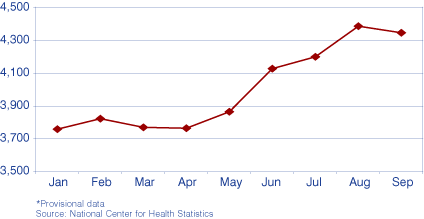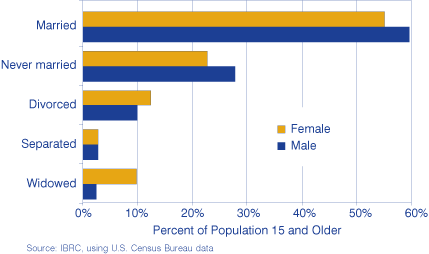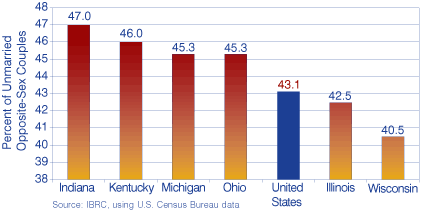'Getting Hitched:' Marriage in Indiana
Named after the Roman goddess of marriage, June has traditionally been one of the most favored months to tie the knot. Last year in Indiana, nearly 4,130 couples married in June, officially kicking off the summer wedding season (see Figure 1). According to the National Center for Health Statistics, over 36,000 couples married in Indiana between January 2005 and September 2005 (slightly down from the 2004 numbers for that same time period). So, what do the data have to tell us about marriage in Indiana?
Figure 1: Marriages in Indiana, 2005*

Marital Status
As seen in Figure 2, over 2.7 million Hoosiers are currently married, which equates to 60 percent of men and 55 percent of women age 15 and older, according to the 2004 American Community Survey (ACS). An additional three percent are married, but currently separated from their spouse.
Figure 2: Indiana Marital Status, 2004

About 531,500 Hoosiers are currently divorced, which breaks down into 10 percent of men and 12 percent of women. Almost 294,000 people have lost their spouse and not remarried; Widows account for 10 percent of all women age 15 and older, while widowers are a mere 2 percent of men.
Meanwhile, 28 percent of men and 23 percent of women have never married. Roughly 80 percent of those in the never married category are under the age of 35. Since the median age at first marriage for Hoosiers is 26 for men and 24 for women, many in that age group either have not found Mr. or Ms. Right or are delaying marriage for other reasons, one of which is cohabitation.
Unmarried Couples
Couples living together prior to (or in lieu of) marriage is a growing trend, accounting for 5 percent of all Indiana households; that's almost 128,000 households, according to the 2004 ACS. The Census Bureau jargon for this phenomenon is unmarried-partner households. The vast majority (87 percent) of unmarried-partner households are heterosexual couples, with same-sex couples accounting for 13 percent—or less than 1 percent of all households in the state.
Since Census 2000, the number of unmarried couples in Indiana has increased 2.5 percent. However, the decennial census captures some additional detail on unmarried opposite-sex partners not captured in the ACS data:
- The average ages for cohabitating Hoosiers are 36 years old for the man and 33 years old for the woman; meanwhile, the average ages for married Hoosiers are 49 years old for the husband and 46 years old for the wife.
- Indiana has a higher percentage of unmarried-partner households with children under the age of 18 than found nationwide. Forty-seven percent of cohabitating households contain children, ranking Indiana eighth among all 50 states and first among Midwestern states (see Figure 3).
Figure 3: Percent of Unmarried Opposite-Sex Couple Households with Children Under 18 Present, 2000

Local Marital Status
If we want to look at the county level, we must also use Census 2000. Several observations can be made from the maps in Figure 4, which use the population age 15 or older as their base:
Figure 4: Percent of Population 15 and Older, Census 2000

- College communities have the largest percent of their populations who have never married. That's rather understandable, with Monroe and Tippecanoe counties coming in at 45 percent and 38 percent, respectively.
- Married couples really do move out to the suburbs; Hamilton and Hancock counties top this list, as 68 percent or more of their populations are currently married.
- South-central Indiana appears to have a particularly high concentration of divorcees. Scott and Marion counties lead the state, with divorcees accounting for more than 13 percent of their respective populations.
- Four of the top five counties with the highest percentages of widows and widowers border Illinois. Vermillion County ranks first at 10 percent.
For additional maps broken down by gender, go to the thematic map gallery on STATS Indiana (www.stats.indiana.edu).
Notes
- According to the Census Bureau, “The identification of the partner's own children in an unmarried partner household is complicated when the child of the partner is not the biological child of the householder, because the Census 2000 questionnaire recorded only each person's relationship to the householder. In circumstances where the child of the partner was not related to the householder, an actual family unit may not be identified in the tabulation.” To address this issue, the Census Bureau uses an expanded child-defined universe (own and/or unrelated children) to capture the presence of a partner's children in unmarried-partner households.
Rachel Justis, Managing Editor
Indiana Business Research Center,
Kelley School of Business, Indiana University
